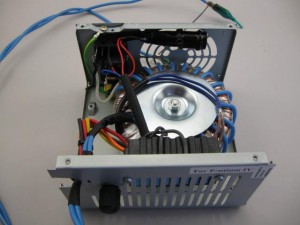 Construction Construction
It had to be constructed into a box to be safe. The 500K potentiometer of the controller is live at mains potential on the terminals but has a plastic body and shaft, and plastic knob. The potentiometer is pretty crappy quality, but safe for the user. It also needed a fuse on the incoming mains just in case the controller failed or the output was directly shorted; although a short may not blow the mains fuse.
A failed PC power supply provided the enclosure. Metal, ventilated, earthed and pre-wired with IEC mains connector and power switch. A couple of holes drilled and some assembly required. A couple of hours and construction was complete.
Testing and Protection
The main question is: will the controller survive? It’s a phase controller, probably leading edge as this is cheap and simple using a Triac. Just a standard light dimmer really, but we hope a bit more robust. The transformer is an inductive load and buzzes at low power settings as there are only short sharp energy pulse being applied. At higher power, more of the AC waveform is applied. This messes with the clip-on ammeter; sometimes it reads, sometimes it’s way off.
The power is adjusted using the knob. 3/4 travel is about 22 Amps with this wire. Shorter wire lengths will draw more current up to a point. There is resistance in the transformer winding and output lead that will limit the maximum current at some point. A output fuse is a possibility but will add a volt-drop and will probably need screw terminals to be reliable.
The controller has survived testing with a standard ss-wire, being ramped up and power applied at a 3/4 setting onto a cold wire.
|